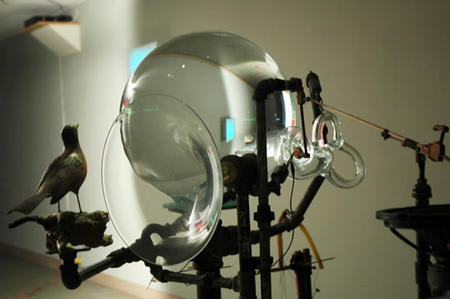Mark Zirpel, Bird Transducer, 2007
blown glass, mixed media, 68.5 x 79 x 101 inches (installed)
Photo. M. Zirpel
It’s been six years since Seattle artist Mark Zirpel’s brilliantly creepy Celestial/Terrestrial at Bullseye, but the artist has clearly been busy concocting new nightmares and comedic riffs for his astonishing new show, Queries in Glass. In its breadth, density and sheer invention, this is one of the most breathtaking, head-scratching shows Portland has seen in quite some time, filling (perhaps over-filling) the gallery’s cavernous, windowless upstairs exhibition space with a baffling panoply of mixed-media works. With mad-scientist glee, Zirpel cobbles together inscrutable devices out of rusty gears, wires, wood, glass and other diverse materials.
In his Orrery series, spheres revolve around a metal sun, an astronomical theme repeated in Orb Machine, whose optical lenses slowly eclipse one another, hanging from a motor-powered bicycle-wheel device overhead. Nearby, the impish Flying Cochlea traverses a wire just below the ceiling like a robotic tightrope walker. This brand of absurdism manifests as body humor in Sibling, in which liquid-filled jugs rise and fall on hydraulic pillars, tubes connecting and channeling fluid between them like a gastric tract. When the liquids reach key levels within the jugs, crude whistles blow off the excess air inside them, filling the gallery with shrill noise. Among the blown-glass pieces, Rain Organ is the most impressive, an intricate set of hanging vitrines and valves. It looks like a chandelier designed by Rube Goldberg. Meanwhile, the show’s most bizarre piece (which is saying something) is called Bird Transducer and may just be impossible to describe. The basic ingredients are a feather, a fake bird, a glass gramophone horn and an oversized crystal ball straight out of The Wizard of Oz. Somehow, vibrations make parts move, a green laser displays waveforms, there are sounds, there are dazzling visions viewed through the crystal ball, and eventually you get the feeling that there must be a higher meaning to all of Zirpel’s steampunk-flavored arcanum—or else the scientist must truly be mad, God must be dead and the rest of us must have one foot in the asylum.
Notably, amid the Mad Max phantasmagoria filling the space’s every cranny, the most effective pieces are the simplest. The kilnformed glass panel called Beach is a rippling reverie in seafoam green, its immaculate execution and thoughtful shadowplay proving that while bells and whistles make a lot of noise, craft and restraint sing even more poetically. - Richard Speer
Source Link: More information
![]() Download: Mark Zirpel, January 11, 2011
Download: Mark Zirpel, January 11, 2011
